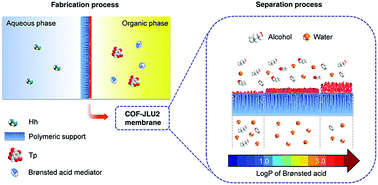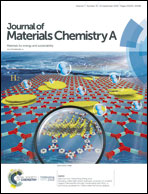Brønsted acid mediated covalent organic framework membranes for efficient molecular separation†
Abstract
Covalent organic frameworks (COFs) hold great promise in molecular separation. However, since the aperture size of most COFs is in the range of 0.8–4.9 nm, constructing COF membranes with a smaller aperture size is thus in urgent demand yet remains a grand challenge. In this study, a Brønsted acid mediated one-step self-assembly method for the fabrication of COF membranes is proposed by segregating the organic phase (containing Brønsted acids and aldehydes) from the aqueous phase (containing amines) with a polymeric support and implementing an interfacial polymerization reaction thereby. Brønsted acids, serving as a versatile mediator, can facilitate the amorphous-to-crystalline transformation, ensure the confined membrane growth at the interface and regulate the assembly behavior of COF subunits, and thus play a critical role in manipulating the microstructure evolution of COF-JLU2 membranes. More intriguingly, a correlation among membrane structures, separation performance and the partition coefficient (log P) of Brønsted acids was established. When log P lies in between 1.0 and 3.0, the COF membranes with continuous active layers, tunable thickness (50–400 nm) and small aperture size (0.49–0.51 nm) can be fabricated, achieving superior alcohol dehydration performances to all the reported membrane counterparts. Our findings may stimulate further research on bottom-up construction of COF membranes and other kinds of organic framework membranes (XOF membranes).



 Please wait while we load your content...
Please wait while we load your content...